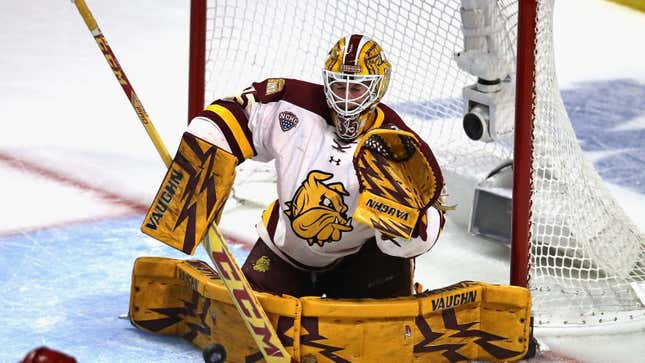
When the coronavirus pandemic hit America earlier this year, one of the first sporting events to be canceled was college hockey’s Frozen Four. It’s a sign of how badly things have gone here that it’s getting harder and harder to see the way to the event taking place in 2021, because at the moment, the entire season appears in danger.
Last week, the Yale men’s team saw 18 of the 19 players on campus come down with COVID-19, a particularly alarming outbreak because the Bulldogs had taken great care to set up safety protocols to try to avoid exactly that outcome.
Now, the men and women at Dartmouth and the University of New Hampshire have had to suspend practice amid a state-mandated two-week closure of all indoor ice rinks, as cases spike in the Granite State.
Massachusetts began its own skating lockdown on Friday, with the state Department of Health saying in a statement that there have been “at least 30 clusters of COVID-19 associated with organized ice hockey activities … totaling 108 confirmed cases.”
Between Massachusetts and New Hampshire, that’s more than 20 percent of Division I hockey programs that have been banned from taking to the ice by order of their states, with other states appearing poised to follow suit with bans. Vermont announced that it’s looking at hockey, specifically while Maine has so far only put the brakes on youth hockey games after a COVID-positive referee exposed as many as 400 people to the virus.
That’s in New England, the part of the country with the least severe coronavirus problems at the moment. As the virus spikes brutally across the upper Midwest, they’re still somehow planning to start the Big Ten hockey season in three weeks, although the schedule hasn’t been finalized. At Minnesota, the women’s team has been practicing four days a week and getting weekly COVID tests, but they don’t know if the Western Collegiate Hockey Association will greenlight the season.
In a CDC study of a coronavirus outbreak stemming from a recreational hockey game in Florida this summer, David Atrubin, Michael Wiese, and Becky Bohinc wrote, “The ice rink provides a venue that is likely well suited to COVID-19 transmission as an indoor environment where deep breathing occurs, and persons are in close proximity to one another. … The indoor space and close contact between players during a hockey game increase infection risk for players and create potential for a superspreader event, especially with ongoing COVID-19 transmission.”
Updated on Oct. 23 at 6:20 p.m. That would caution against having a college hockey season at all, although one of the sport’s western leagues, the National Collegiate Hockey Conference, is planning a partial bubble in Omaha, Nebraska, for a season to begin on Dec. 1. Each team would play 10 games over three weeks in the “Pod,” with the schedule consisting of eight out-of-division games and two divisional contests.
After that, the plan would be for the teams to play exclusively in their divisions to limit travel, with the East consisting of Miami (Ohio), Minnesota-Duluth, St. Cloud State, and Western Michigan, and the West being comprised of Colorado College, Denver, North Dakota, and Omaha.
It’s obviously way too early to try to guess what the pandemic situation might be like in January, when the NCHC’s out-of-pod play would begin, but it’s not like Ohio is super close to Minnesota, nor Colorado and North Dakota. There’s an attempt to mitigate risk, but there’s inherently a huge amount of risk with the endeavor, including the six weeks between now and the start of “Pod” play, during which the kids on these teams will be in and out of ice rinks in states where the virus is out of control.
That’s a risk the NCHC takes even with its plan for some level of isolation, because what the science is saying is that going to the rink in the first place, regardless of the NHL’s success with Toronto and Edmonton bubbles, is inviting outbreaks. We’ve seen plenty of leagues across the United States disregard the advice of scientists and forge ahead with seasons that have resulted in near-constant infections. But it’s not just hockey.
“The high proportion of infections that occurred in this outbreak provides evidence for SARS-CoV-2 transmission during an indoor sporting activity where intense physical activity is occurring,” the study authors wrote.
So, don’t be so sure that basketball is going to go smoothly this winter, either, just because the NBA managed to pull off its bubble. The pandemic already wiped out one college hockey and basketball championship. Before the new season even starts, it wouldn’t be surprising at all to see another.